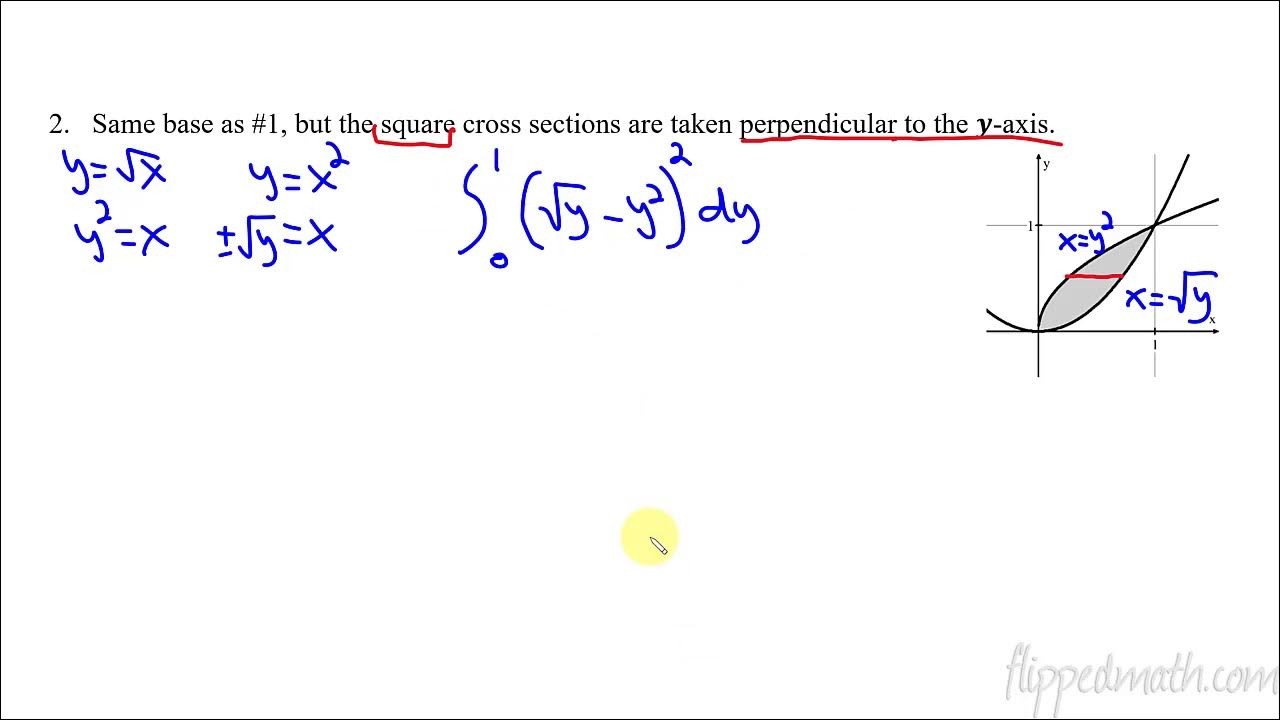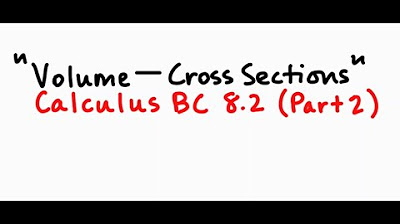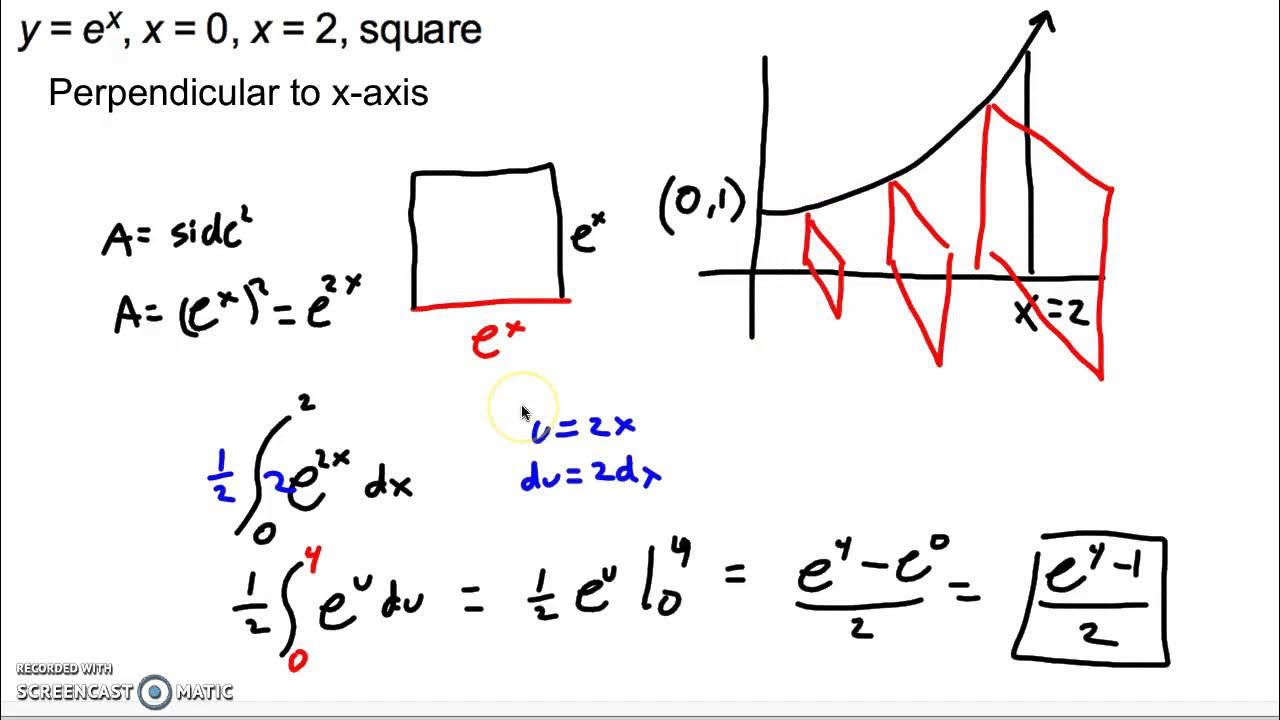Calculus AB/BC – 8.8 Volumes with Cross Sections: Triangles and Semicircles
TLDRIn this engaging calculus lesson, Mr. Bean delves into the intricacies of calculating the volume of a solid using cross-sections. The focus is on understanding how to work with cross-sections that are either triangles or semi-circles. He explains that the volume is determined by integrating the area of a known cross-section across an interval from 'a' to 'b'. The lesson covers the area calculations for equilateral triangles, isosceles right triangles, and semi-circles, emphasizing the importance of knowing the formula for the area of a circle and how to adjust it for semi-circular cross-sections. Mr. Bean also highlights the need to identify the radius correctly, especially for semi-circles, by taking half of the difference between two functions representing the bounds of the solid. The lesson concludes with a reminder to practice these calculations both with respect to 'x' and 'y', as it is a crucial skill for mastering calculus.
Takeaways
- 📚 Today's lesson focuses on calculating the volume of a solid using cross-sections that are triangles or semi-circles.
- 🔍 To find the volume, integrate the area of a known cross-section across an interval from 'a' to 'b'.
- 🧊 An equilateral triangle's cross-section has all sides of equal length, and its area formula is (√3/4)s^2, where 's' is the side length.
- 📐 For an isosceles right triangle, the area is half that of a square with side length equal to the triangle's leg, calculated as (1/2)leg^2.
- ⭕ The area of a semi-circle is half the area of a full circle, which is (1/2)πr^2, where 'r' is the radius.
- 🤔 The radius 'r' of a semi-circle cross-section is found by taking the difference between two functions and dividing by two.
- 📉 When setting up the integral for a semi-circle, the radius is squared and the entire expression is squared as well, resulting in fractions that need to be simplified.
- 🔢 The integral for an equilateral triangle involves squaring the difference between the functions that define the triangle's vertices.
- 📏 For an isosceles right triangle, the integral setup involves the difference between the square of the variable and the variable itself.
- 🔄 It's important to practice both with respect to 'x' and 'y', even though the video focuses on 'x' for simplicity.
- 💡 Semi-circle cross-sections are commonly tested in AP exams, so proficiency in calculating their volumes is crucial.
Q & A
What is the main topic of the calculus lesson described in the transcript?
-The main topic of the lesson is the calculation of volumes of solids using cross-sections, specifically focusing on equilateral triangles and semi-circles.
How does one calculate the volume of a solid when only the cross-section is known?
-To calculate the volume, you take the area of one of the cross-sections and then integrate it across an interval from 'a' to 'b'.
What is the formula for the area of an equilateral triangle?
-The area of an equilateral triangle is given by the formula (√3/4) * s^2, where 's' is the length of a side.
How does the shape of a solid change when the cross-section is a semi-circle?
-When the cross-section is a semi-circle, the solid takes on a shape that is similar to a hemisphere, with smooth semi-circular cross-sections as it is extended.
What is the formula for the area of a semi-circle?
-The area of a semi-circle is half the area of a full circle, which is calculated as (1/2) * π * r^2, where 'r' is the radius of the semi-circle.
How is the radius of a semi-circle determined when it is used as a cross-section?
-The radius of the semi-circle is determined by taking the difference between the two bounding functions (f - g) and then dividing by 2.
What is the area formula for an isosceles right triangle?
-The area of an isosceles right triangle is half the area of a square with side length 's', which is (1/2) * s^2.
What is the integral set-up for calculating the volume of a solid with an equilateral triangle cross-section from 0 to 1?
-The integral set-up is ∫ from 0 to 1 of (√x - x^2) dx, with the area of the equilateral triangle being (√3/4) * side^2.
How does the process of calculating the volume of a solid with a semi-circular cross-section differ from that of an equilateral triangle?
-For a semi-circular cross-section, the volume calculation involves integrating half of π times the square of the radius, where the radius is determined by the difference between two functions divided by 2, all squared and then divided by 4.
What is the integral set-up for calculating the volume of a solid with an isosceles right triangle cross-section from 0 to 1?
-The integral set-up is ∫ from 0 to 1 of (1/2) * (side^2 - x^2) dx, where 'side' is the length of the equal sides of the triangle.
Why is it important to be able to calculate volumes of solids with different cross-sectional shapes in calculus?
-Calculating volumes of solids with different cross-sectional shapes is important in various fields such as engineering, physics, and architecture for designing structures, understanding space capacities, and solving real-world problems involving three-dimensional shapes.
What is the significance of the 'a' to 'b' interval in the context of integrating cross-sectional areas to find the volume of a solid?
-The 'a' to 'b' interval represents the limits of integration, which define the region over which the volume under the cross-sectional area is being calculated. It corresponds to the spatial extent of the solid in one dimension.
Outlines
📚 Introduction to Calculus of Solids with Cross-Sections
This paragraph introduces the topic of calculating the volume of a solid using cross-sections. It builds on previous lessons, focusing on the cross-sections that resemble triangles and semi-circles. The method involves taking the area of a known cross-section and integrating it over an interval from 'a' to 'b'. The speaker uses an equilateral triangle as an example, explaining that the cross-section represents the same length for all three sides of the triangle. The process is visualized by adding more triangles to form the solid shape. The concept is then extended to a semi-circle, with the area of a semi-circle being half the area of a full circle. The importance of knowing the area formulas for different shapes and understanding the integration process is emphasized.
🔢 Calculating Volumes with Different Cross-Sections
The second paragraph delves into the specifics of calculating the volume of solids with different cross-sectional shapes. It starts with equilateral triangles, noting that their area is given by the formula (√3/4)s^2, where 's' is the side length. The side length is determined by the difference between the larger and smaller functions defining the bounded region. The paragraph then moves on to isosceles right triangles, explaining that their area is half that of a square, derived from the side length. Finally, the paragraph addresses semi-circles, noting that they are a common shape in calculus problems. The area of a semi-circle is half that of a circle, which is πr^2. The radius 'r' for a semi-circle is derived from half the diameter, which is the difference between two functions. The paragraph concludes with an encouragement to practice these calculations, both manually and with a calculator, to prepare for exams and further lessons.
Mindmap
Keywords
💡Calculus
💡Volume of a Solid
💡Cross-Section
💡Equilateral Triangle
💡Semi-Circle
💡Integration
💡Area Calculation
💡AP Exam
💡Isosceles Right Triangle
💡Perpendicular
💡Mastery Check
Highlights
Lesson focuses on calculating the volume of a solid using cross-sections that are triangles or semi-circles.
Volumes are calculated by integrating the area of a known cross-section across an interval.
An equilateral triangle cross-section has sides of equal length, and its area formula is √3/4 * s^2.
For an equilateral triangle, the side length is determined by the difference between two curves of a bounded region.
An isosceles right triangle's area is half the area of a square with sides equal to the triangle's legs.
The area of a semi-circle is calculated by taking half of the area of a full circle (πr^2).
The radius of a semi-circle cross-section is half the distance between the two bounding curves.
Integration is used to calculate the volume of the solid formed by stacking the cross-sections.
The area of the cross-section for an equilateral triangle is integrated from y=√x to y=x^2.
For an isosceles right triangle, the setup involves integrating half the area of a square from 0 to 1.
Semi-circle volume calculations are more common in AP exams compared to triangles.
The integral setup for a semi-circle involves π/2 times the square of the difference between √x and x^2.
The radius for a semi-circle is derived from half the diameter, which is the difference between two functions.
The volume calculation involves squaring the fraction representing the radius and integrating it.
Practice problems will include calculations with respect to both x and y axes.
The lesson emphasizes the importance of understanding how to handle fractions and simplifying integrals.
The video provides a foundation for mastering volume calculations with different cross-section shapes.
Students are encouraged to practice and apply the formulas learned in the lesson to various problems.
Transcripts
Browse More Related Video

Calculus AB/BC – 8.7 Volumes with Cross Sections: Squares and Rectangles

Volume of Solids with Known Cross Sections

Topic 43-Volumes of Solids with Known Cross Sections

Calculus Integrals for Volumes with Known Cross Sections

Volumes with Known Cross Sections with Calculus, pg 2

Calculating volume by known cross sections
5.0 / 5 (0 votes)
Thanks for rating: